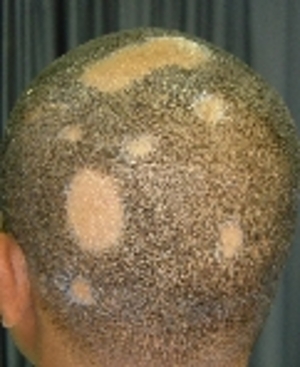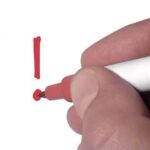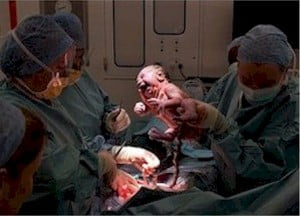Alopecia areata is a localized, patchy, non scarring type of hair loss, characterized by the presence of one or more round or oval hairless patches. The affected skin appears normal and smooth, unlike the fungal infections, where there is crusting of the skin and uneven breaking of hairs. On the periphery of the patches, a few short hairs, which taper and loss pigment as they approach the skin, may be seen. These are called “exclamation mark” hairs due to their resemblance to the mark.
Alopecia areata usually affects the scalp. Other hair bearing areas, especially the beard are also affected. Any age can be affected in alopecia areata; though the common age group is 15-30. The youngest alopecia areata patient I have seen was a 2 year old girl.
Causes of Alopecia Areata:
1. Autoimmune theory: Alopecia areata is thought to be an autoimmune disease where the body produces antibodies (auto antibodies) against the hair germinal cells and cause their destruction in localized areas. The localization of lesions also point towards a neural pathway involvement. In patients with graying hairs, it is common to see that only the black hairs fall off in the patches. Sparing of the grey hairs in alopecia areata indicates that normal nerve supply and melanin pigment is necessary for the alopecia areata to occur.
2. Direct pressure: Many patients get patchy hair loss following direct pressure on hair bearing areas, e.g., from a tight fitting helmet, pressing the head against bed rails for prolonged duration while watching TV etc.
3. Mobile phones and alopecia areata: Another complication of the modern device! Before the hands free sets became common, a number of patients, especially those using cheaper brands of cell phones, presented with alopecia areata on their beards. Possibly the radio waves emitted by the mobile phone damaged the hair follicles and triggered an autoimmune inflammatory reaction in the area. Most of them also had dull aching pains in their ear on the same side.
4. Caries tooth: This is a very important factor usually ignored by patients and their doctors alike. In the Middle East where I practice, there is a very high incidence of alopecia areata. In my practice, I come across almost 6-7% alopecia cases among the total skin diseases. In addition to stress, one common factor that I noticed was the presence of caries tooth in almost all cases with recurrent patchy hair loss, especially on the beard. Research showed that alopecia areata of dental origin has indeed been mentioned in scientific journals.
Personally I make a habit of referring all my alopecia areata patients who come with recurring patchy loss of hair, especially resistant to treatment, to a dental surgeon. Most such patients stop getting recurrences after their teeth infection is taken care of.
Possible explanation of the relationship between caries tooth and alopecia areata: Tooth germinal cells and hair germinal cells have embryological and histological similarities. Hence, the antibodies forming against damaged tooth germinal cells and the bacteria attacking them must be affecting the hair follicles as well. This is only a hypothesis and need to be studied further. The involvement of nail (nail pits) in alopecia areata supports this hypothesis, as nail is another integument of the skin that is similar to the tooth and hair!
5. Stress: Most patients who come with recurrent episodes of alopecia areata also report a preceding period of intense stress in their life. How the stress causes hair loss only in localized patches, is however, not known. Hypothetically the nerve supply and altered immune responses in stress may be playing a role in the causation of alopecia areata. Corroborative studies where cure has been affected following implementation of stress management techniques in non responsive patients point to a positive role of stress in the causation of alopecia areata.
Types of Alopecia Areata
Depending upon the extend of involvement, alopecia areata is divided into:
1. Localized alopecia areata
2. Alopecia totalis: involve the whole scalp, eyebrows, beard
3. Alopecia Universalis: Total loss of body hair
At times, alopecia areata can be quite stubborn in its response to treatment. Many patients continue to get recurrences despite the therapeutic interventions. This definitely calls for further investigations to rule out or confirm causes like unmanaged stress, direct pressure or untreated caries teeth.
Tips on dealing with Recurrent Patchy Hair Loss or Alopecia Areata
1. In many cases hair growth occurs spontaneously in a few months without any medical treatment. A wait and watch approach is indeed a non expensive, safer alternative for a limited number of patients.
But if the patches are getting wider and the hair pulling test is positive, it is wiser to consult your dermatologist.
Hair pulling test: Try pulling out the hairs at the periphery of the patches. If they come out very easily without any resistance, the test is positive. Also these hairs will look like “exclamation marks” with loss of pigment and thinning just above the hair roots.
2. The first hair re growth after treatment or spontaneous regrowth will show fine, non pigmented or grey hairs. There is no need to worry as normal, pigmented hair will come out sooner or later.
3. Do not apply contact irritants from “helpful” friendly advices or home remedy tips! This may cause further worsening of the lesions and sometimes even cause permanent scarring if the irritant reaction is severe. It is to be noted that mild counter irritant effect does actually produce hair growth in some patients of alopecia areata. Possibly new inflammatory cells attracted to the area may be flushing out the auto antibodies and releasing the hair roots from their inhibitory effects.
4. Intradermal injection with corticosteroids is a very effective treatment for alopecia areata. This procedure should only be done by an experienced dermatologist as proper dilution, quantity and depth are necessary to produce optimum results. I have come across quite a number of patients scarred for life with skin atrophy and leucoderma following undiluted steroid injections given by pharmacists and non dermatologists. This is very unfortunate and should be avoided by all means.
5. Like wise, application of topical steroids should be done only under medical supervision. Super potent steroids applied on face can cause permanent damage to the facial skin.
6. If you are getting new patches of hair loss despite treatment, look for hidden infections in the teeth. Get a dental consultation.
7. Review whether you are causing undue pressure on the area with tight fitting helmets or scarves, improper shaving techniques etc. Also correct your posture while sleeping or watching TV.
8. Use hands free sets or blue tooth for your cell phones. This will reduce the damaging effects of the radio waves emitted by the sets.
9. Measure Your Stress Levels. If your stress level is high, learn how to manage the stress. A sense of perceived loss of affection from the near and dear may be the underlying problem in the causation of patchy loss of hair. I have seen young children of 2-5 years age getting alopecia areata within a few months after their younger siblings are born. It is clearly the imagined or real loss of attention and affection from the parents that is the culprit in such cases. Parents have to take extra care to convey the message that the newcomer in no way interferes with their affection for the elder one.
10. Once the hair loss has stopped and new patches stop appearing, you can boost the hair growth with medications like minoxidil and vitamin supplements. This will hasten the growth and also provide additional nourishment for the newly sprouting hair roots.
Disclaimer: Information provided in this article is strictly for educational purposes and is not meant to substitute for the advice provided by your own dermatologist or other medical professionals. You should not use the information contained herein for diagnosing or treating a health problem or disease, or prescribing any medication. Many skin diseases have similar morphology and may resemble one another, though their treatment protocol varies. Hence, self diagnosis and treatment are not advised. In case of doubt always be on the safer side and consult your dermatologist or physician.






